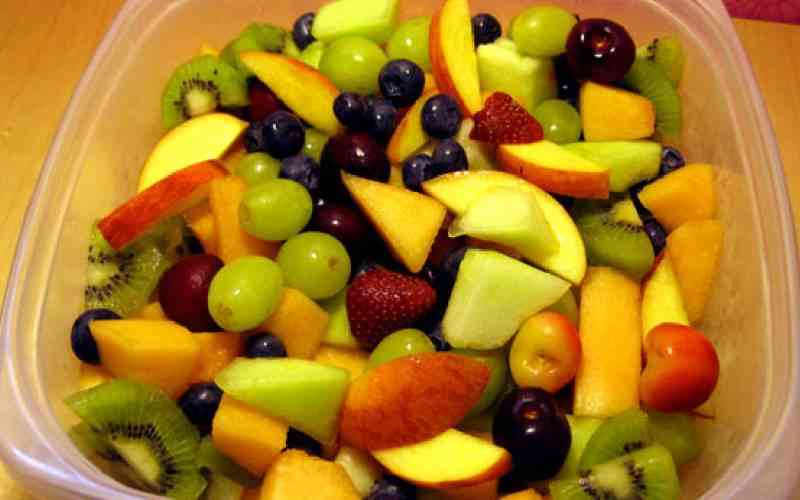
Fruit salads are a popular and nutritious choice for those aiming to include more fruits in their diets.
However, preparing a healthy fruit salad involves more than just mixing different fruits together.
It requires understanding nutritional interactions, as well as considering pharmacodynamics and pharmacokinetics. Improper fruit combinations, poor hygiene, and lack of knowledge about nutrient interactions can lead to adverse health effects.
Nutritional interactions in fruit salads can impair digestion, reduce nutrient absorption, or cause harmful side effects.
In Kenya, the unregulated sale of fruit salads by roadside vendors adds to these risks. Many vendors lack the necessary nutritional knowledge and hygiene standards to ensure safe and effective preparation.
Fruits can be classified into three main categories.
1.Acidic Fruits
Examples: Oranges, lemons, grapefruits, pineapples
Key properties: Rich in citric acid, which aids digestion and enhances vitamin C absorption. However, they may interfere with the digestion of sweeter fruits.
2. Sub-Acidic Fruits
Examples: Apples, pears, berries
Key properties: These fruits have moderate acidity and are versatile for pairing with both acidic and sweet fruits. They are high in fiber, which supports digestive healty.
3.Sweet Fruits
Stay informed. Subscribe to our newsletter
Examples: Bananas, mangoes, papayas
Key properties: These fruits are rich in natural sugars and should be consumed separately from acidic fruits to prevent fermentation and bloating.
Beneficial and Harmful Fruit Combinations
Recommended Fruit Combinations
Citrus fruits with other acidic fruits Examples: Oranges and pineapples; grapefruits and kiwis
Benefits: Rich in vitamin C, these combinations support immune function, collagen synthesis, and iron absorption.
Sub-Acidic Fruits with Acidic or Sweet fruits
Examples: Apples with oranges; pears with bananas
Benefits: High fiber content helps regulate blood sugar and supports digestion. Sub-acidic fruits also act as a bridge between the other categories, promoting better digestion and nutrient absorption.
-Berries with Other Fruits
Examples: Strawberries with bananas or apples
Benefits: Berries are rich in antioxidants and vitamin C. Combining them with other fruits like bananas or apples enhances their antioxidant properties and improves cardiovascular health.
- Sweet Fruits with Other Sweet Fruits
Examples: Bananas with mangoes; papayas with melons
Benefits: These combinations promote smooth digestion without fermentation or bloating.
- Melons with Specific Additions
Examples: Watermelon or cantaloupe with mint
Benefits: High water content in melons aids hydration and digestion.
Harmful Fruit Combinations
1. Citrus Fruits with Dairy
Examples: Oranges or lemons mixed with milk or yogurt
Issue: The acidic nature of citrus fruits curdles dairy proteins, leading to indigestion and reduced calcium absorption.
2. Citrus Fruits with Certain Medications
Example: Grapefruit
Issue: Grapefruit can interact with medications like statins, immunosuppressants, and antihistamines, increasing their toxicity.
3. Watermelon with Other Fruits
Issue: Watermelon is highly water-dense and digests quickly. Mixing it with slower-digesting fruits like bananas or mangoes can lead to bloating and discomfort.
4. Guava with Antioxidant-Rich Fruits
Examples: Guava with grapes or blueberries
Issue: Guava’s high fiber content can interfere with the absorption of antioxidants from other fruits, reducing their effectiveness.
5. High-Potassium Fruits with Antihypertensive Drugs
Examples: Bananas and avocados
Issue: These fruits are rich in potassium, which can cause hyperkalemia (high potassium levels) in individuals taking potassium-sparing diuretics or ACE inhibitors.
6. Acidic Fruits with Sweet Fruits
Example: Mixing pineapples or oranges with bananas
Issue: The acidic fruits digest quickly while sweet fruits take longer, potentially causing bloating and discomfort.
7. Fruits High in Tannins
Examples: Persimmons
Issue: Fruits high in tannins can interfere with digestion when combined with other fruits. It’s advisable to consume these fruits separately.
8. Fruits High in Tyramine with MAOIs
Examples: Avocados, bananas
Issue: Tyramine-rich fruits, when combined with monoamine oxidase inhibitors (MAOIs), can cause a hypertensive crisis, a dangerous spike in blood pressure.
Nutrient-Nutrient Interactions in Fruit Salads
Vitamin C and Iron
Positive interaction: Citrus fruits enhance the absorption of non-heme iron from plant-based foods. Example: Combining oranges with strawberries or apples.
Calcium and Oxalates
Negative interaction: Oxalate-rich fruits, such as starfruit and rhubarb, can bind to calcium and reduce its absorption.
Vitamin A and Healthy Fats
Positive interaction: The fat-soluble nature of vitamin A requires dietary fats for optimal absorption. Combining mangoes or papayas with avocado can improve vitamin A uptake.
Fructose Overload and Blood Sugar Spikes
Issue: Excessive consumption of sweet fruits like mangoes and grapes can cause rapid blood sugar spikes, particularly problematic for diabetic individuals.
Polyphenols and Iron
Negative interaction: Polyphenol-rich fruits, like berries, can inhibit non-heme iron absorption, which is concerning for those with anemia.
Gastrointestinal Distress
Mixing acidic and sweet fruits can cause bloating and gas due to differences in digestion rates. This discomfort may discourage individuals from consuming fruit salads altogether.
Nutrient Deficiencies Poorly mixed fruit salads can lead to nutrient deficiencies over time if key nutrients are not absorbed effectively due to interactions.
Potential Allergies
Some individuals may have sensitivities to specific fruits like kiwi or pineapple. Combining them with other allergens can increase the risk of an allergic reaction.
Public Health Concerns in Kenya
The unregulated availability of roadside fruit salads in Kenya poses a significant public health risk:
Unhygienic Preparation**
Roadside vendors often operate in unsanitary conditions, increasing the risk of foodborne illnesses such as salmonella and Ecoli.
Unknown Fruit Sources
The origin and quality of fruits used in roadside salads are often uncertain. Fruits may be exposed to excessive pesticides or harmful chemicals.
Lack of Nutritional Expertise Many roadside vendors lack knowledge about fruit combinations and safe food handling practices. They may mix incompatible fruits, causing digestive issues or nutrient malabsorption.
Unsafe Storage Conditions
Fruits stored in high temperatures are more prone to bacterial growth, increasing the risk of foodborne illness.
Recommendations for Public Safety
1. Empowering Nutritionists and Dietitians Nutritionists and dietitians should train vendors on proper fruit selection, combination, and safe handling practices. They should also develop public education materials.
2. Training for Vendors Local health authorities should mandate training programs focusing on food safety and nutrition principles. These should be overseen by registered nutritionists.
3. Certified Vendors Near Hospitals like Nairobi Hospital and Aga Khan should have certified fruit salad vendors nearby who meet stringent hygiene and nutritional standards.
4. Licensing and Training County governments should require fruit vendors to undergo formal training in nutrition and hygiene, supervised by registered nutritionists.
5. Oversight by Nutritionists
Registered nutritionists and dietitians should oversee fruit salad preparation, particularly in urban areas, to ensure compliance with safety standards.
6.Public Awareness Campaigns
Regular public health campaigns should be held to educate the public on proper fruit preparation, the risks of buying from unregulated vendors, and safe fruit combinations.
7. Improved Enforcement by County Health Departments
County health departments must regulate fruit salad sales and penalize vendors who do not meet hygiene and safety standards.
Medical Oversight
Having nutritionists oversee fruit salad vendors near medical facilities can prevent adverse drug-nutrient interactions. For instance, a hypertensive patient on potassium-sparing diuretics might unknowingly consume a fruit salad high in potassium, leading to hyperkalemia. These incidents highlight the need for trained professionals to oversee fruit salad preparation.
Omollo is the founder and president of the Kenya Nutrition and Dietetics Students Association (KENDSA).







